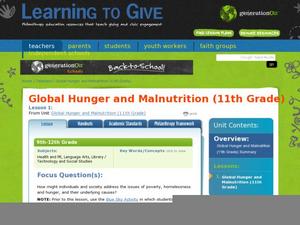Curated OER
Global Hunger and Malnutrition
Is there a difference between hunger and malnutrtion? Is this a problem only in third world countries? How does hunger and malnutrition affect the community? Why do these problems exist when the world produces enough food to feed...
Curated OER
Walking in Other People's Shoes
Students study the story of student journalist Casey Parks' September, 2006, journey to Central Africa with New York Times columnist, Nicholas Kristof. They then act as representatives to the tourism boards of developing countries and...
Curated OER
The Wrath of Hurricane Mitch
Students investigate how hurricanes and other natural disasters can devastate the elements of the infrastructure of a country, as well as the lives of its people.
Curated OER
Mobile Phones
Investigate how mobile phones impact their lives through this technology instructional activity that has students discuss the history of the cell phone and research how cell phones are being used in third world countries. Students create...
Curated OER
How Are Boundaries Made, Kept, Broken?
Students perform raps and analyze issues among the rich and poor. They explore how countries are labeled as "third world" and "first world." They create a dialectical journal and examine the country of Nigeria through the reading of...
San Diego State University
World History for Us All: Two Big Powers and Their Cold War 1945 1990 [Pdf]
After completing this unit, learners will be able to describe major differences in the political ideologies of the United States and the Soviet Union, explain the causes of the Korean War and the Cuban Missile Crisis, and explain how...
ClassFlow
Class Flow: Addressing Poverty
[Free Registration/Login Required] Creative thinking skills lesson- begins by briefly looking at what poverty is, and then challenges the students to think of solutions without framing answers for them.







![World History for Us All: Two Big Powers and Their Cold War 1945 1990 [Pdf] Lesson Plan World History for Us All: Two Big Powers and Their Cold War 1945 1990 [Pdf] Lesson Plan](https://d15y2dacu3jp90.cloudfront.net/images/attachment_defaults/resource/large/FPO-knovation.png)
